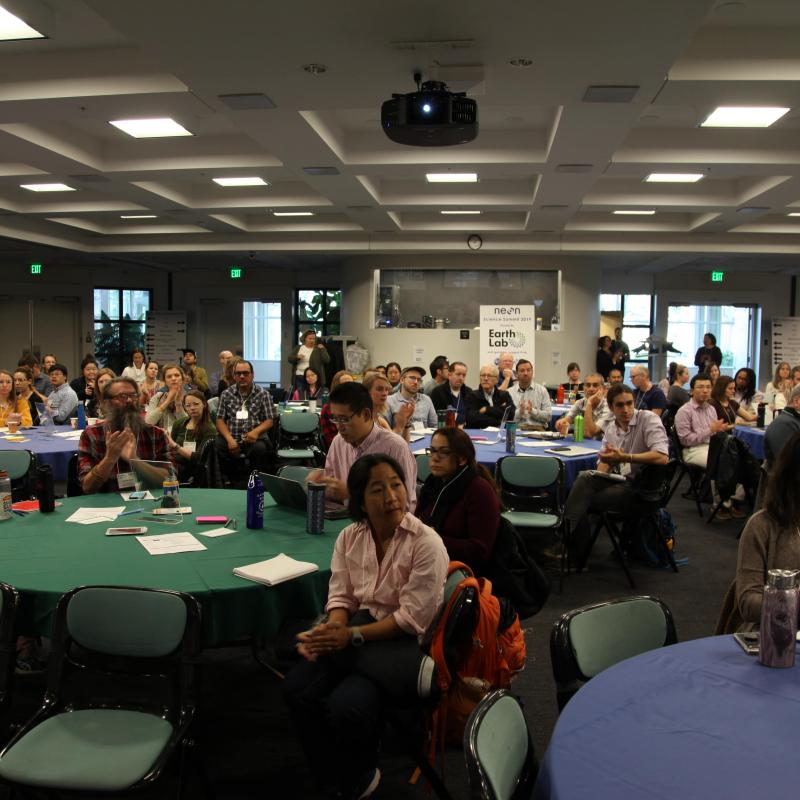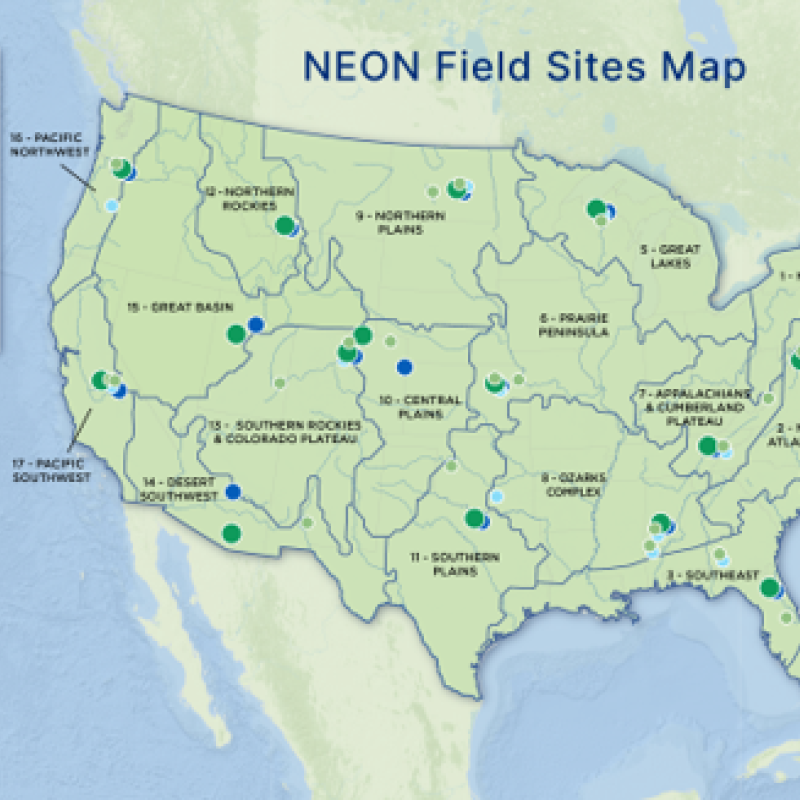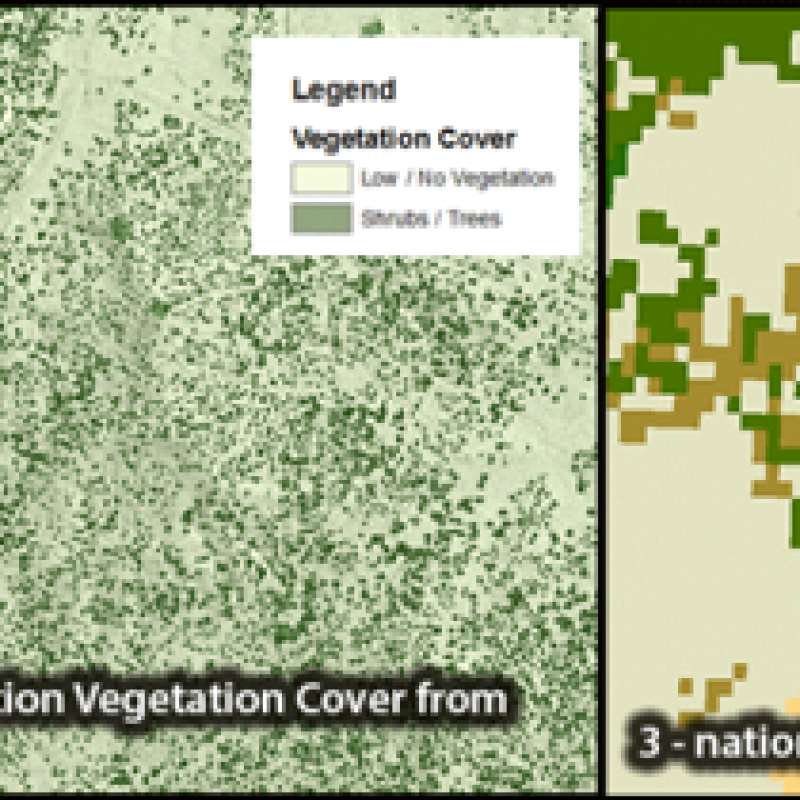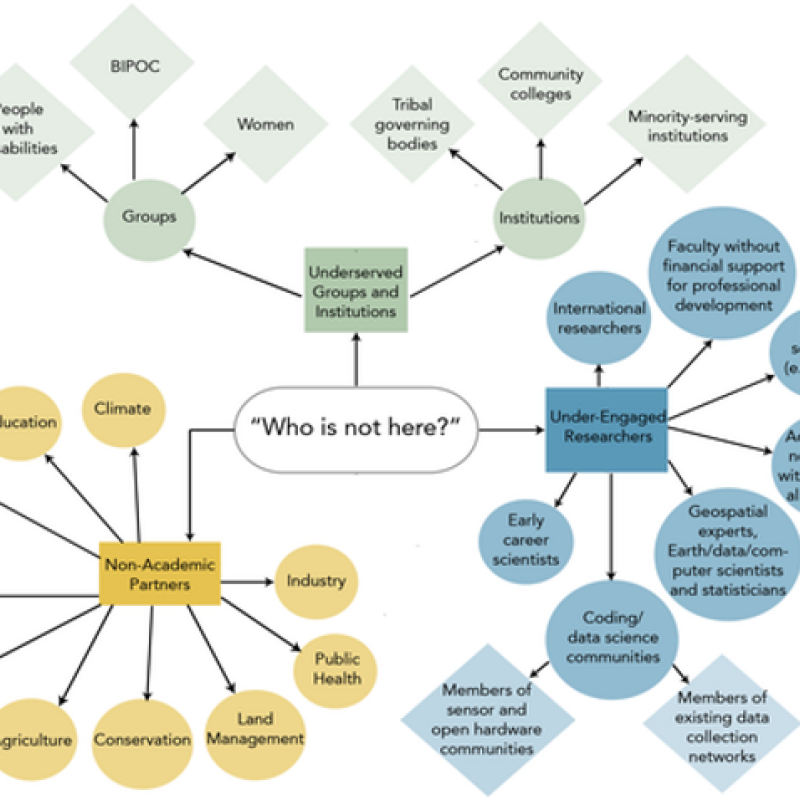Harnessing the NEON Data Revolution
This blog summarizes a recent publication: Harnessing the NEON data revolution to advance open environmental science with a diverse and data-capable community, co-led by Earth Lab Program Manager Dr. Chelsea Nagy & Director Dr. Jennifer Balch and 118 additional co-authors. Read the full, open-access paper here (DOI: https://doi.org/10.1002/ecs2.3833).

Image of Day 1 of the 2019 NEON Science Summit.
How do you track environmental change across an entire continent? What happens when you can’t compare data because they were collected differently or are in different formats? Even if you find out about a great dataset, what happens if you can’t access it or don’t know how to use it?
These questions are all too common for many ecologists, who are often seeking answers about big, interconnected questions without easy solutions. Environmental challenges facing today’s society require thinking across scales from local to continental or global, data collected across different ecoregions and over decades, multidisciplinary expertise, team science approaches, and training in skills like computer and data science.
The National Ecological Observatory Network (NEON) seeks to enable the ecological community to quantify and understand ecological processes over time and space. A fundamental goal of NEON is to improve our understanding of and ability to predict the effects of environmental change (e.g., climate change, land-use change, biological invasions, altered nutrient cycling) at continental scales representing both terrestrial ecosystems, aquatic ecosystems, and the atmosphere.
What is NEON?

Figure 1: NEON ecoclimatic domains and field sites. Light/dark green dots correspond to terrestrial sites while light/dark blue dots correspond to aquatic sites. Credit: NEON
The network is a series of 81 sites located around the United States, representing a variety of different ecosystems, that produce ecological data products via standardized sampling procedures. NEON delivers a coordinated set of calibrated and documented data on key plant and animal groups as well as microbes and algae, environmental and atmospheric variables, and remote sensing data. These data can help reveal linkages between ecological patterns and processes across scales as well as identify drivers of change and the resultant ecological consequences. NEON’s design and sampling protocols allow for meaningful connections to be made by integrating across datasets, and its data products have great potential to be used in conjunction with field ecology insights to better answer key environmental questions.

Figure 2: NEON collects measurements via various methods from in situ field collection (1) to higher-resolution airborne data (2). NEON's higher-resolution in situ and airborne data can be integrated with existing satellite derived products (3) to create continental datasets. Credit: NEON
The history of NEON includes at least a decade of workshopping and planning, and in 2011, the National Science Foundation (NSF) approved funds to build NEON. While some data products were available as early as 2010, it was not until 2019 that all site construction was completed and all data products were accessible. Thus, after almost 20 years of envisioning, planning, and construction, NEON is now fully operational.
While there were many early adopters, the community of NEON users could benefit from greater diversity and cohesion. Furthermore, while much of the community understands the power of the data being produced by the Observatory, many potential users may face barriers to utilizing these data sets. Therefore, Earth Lab at the University of Colorado Boulder hosted the first NEON Science Summit in 2019 to continue to build a robust and sustainable NEON user community, which is essential for the Observatory to realize its full potential.
In total, there were 170 participants through a mix of in-person and remote participation in an “unconference”-style meeting. Our recent Ecosphere paper synthesizes the work from the 2019 NEON Science Summit and the Grand Challenges that the NEON user community identified as priority areas to address.
NEON Open Science
Open science principles and methods (e.g., making samples, data, workflows, software, publications freely available) are changing the field of ecology. As a key tenet of the NEON mission at the outset, this commitment to open science has the potential to accelerate ecological research and increase the diversity of scientists involved by removing barriers to access. NEON has the potential to be on the forefront of open ecology, and therefore Summit participants shared their thoughts about opportunities and challenges in this area.
Key opportunities that are expected to bring added value to open NEON data include the following: harmonization with other observatory networks and data sources, training and utilization of best practices in open science for the NEON user community, and sharing of tools for using NEON data across the community.
All components of NEON data collection and instrumentation are documented and intended to be used as community standards. The science carried out using NEON data must be open and reproducible, encouraging the creation of centralized online space to store, review, and share tools and software to build upon each other’s efforts. Yet successfully building a community of scientists who share code, software, and data products built upon NEON data is one of the key challenges identified during the Summit and requires community adoption of best practices. These best practices include:
- Making code accessible with permissive licensing, citable using DOIs, well-documented and maintained over time to support reproducibility and re-use.
- Making scalable cyberinfrastructure to host NEON data available for those with limited access to computational resources (e.g. small or underserved institutions).
- Leveraging existing tools to make NEON data more discoverable, adding to the broader NEON toolbox.
The scientific community has already built many different tools and products to make workflows for processing and analyzing NEON data more efficient; however, these efforts are often disconnected and the tools developed are not easily discoverable. There are several potential advantages to sharing resources among NEON users including (1) reduced redundancy in efforts as groups independently develop tools with similar functionality; (2) adoption of methods or algorithms with novel approaches better suited for tackling questions with the available volume of data rather than those traditionally used by a specific community; and (3) lower investment of skills, resources, and time for individual groups that do not have pre-existing tools and workflows.
NEON Applications
While much thought has been given to what will be possible with NEON data over the course of decades, the focus of the 2019 NEON Science Summit was to determine what can be done with NEON data and NEON-compatible products right now and in the next decade. The following are the main research areas that the community is addressing through individual efforts and group work that stemmed from the Summit.
- Fundamental Ecology
- Biodiversity across Scales
- Evaluating disturbance dynamics
- Carbon and Climate Dynamics
- Situating NEON in a coupled human-environment systems framework
- Ecological forecasting
Some emergent topics identified by the Summit participants include:
Foundational ecology
- What controls metabolic rates?
- What drives trait variation?
- What are the patterns in biodiversity across taxa—from beetles to trees?
- What controls decomposition or transpiration rates?
Species from space
- How can tree species of individual tree crowns be identified?
- How do spectral signatures correspond to leaf traits?
Change detection and forecasting
- What’s the phenological response to interannual variability in climate?
- How is the hydrology of streams changing?
- What would it take to forecast ecological processes?
Invasive species
- How does plasticity of the genome level predict plant success, across native and invasive species?
Data harmonization and scaling
- How can different types and sources of data be integrated?
- How does ecological pattern and process scale?
Diversity, Equity, Inclusion, and Accessibility (DEIA) & Education in NEON
There is the potential to capitalize on NEON’s vast resources to grow a diverse and inclusive user community while also addressing persistent disparities in STEM participation. While open NEON infrastructure and data are central draws (and by themselves remove a key barrier of the resources needed to collect empirical data that many researchers lack), training opportunities (e.g., workshops that provide hands-on experience with the data) and networks of people are critical for building a diverse and inclusive community and expanding professional opportunities of the community.
Diverse backgrounds are critical to developing innovative and creative scientific perspectives and solutions and will expand the visibility of NEON beyond the current ecological community. Post-event anonymous surveys following the 2019 NEON Science Summit indicated that 31.3% identified as non-white and 55% identified as female. During the NEON Science Summit, participants were asked to consider the question: “Who isn’t here and how can they be brought into the fold?” Many of the responses went beyond identification of racial and ethnic minorities and emphasized the importance of building a coalition of NEON data users that includes a wide range of perspectives and members beyond the academic ecological research community (Fig. 3).

Figure 3: Responses to the question asked of 2019 NEON Science Summit participants about who was not at the Summit that should have been (i.e., who or what groups were not well represented).
However, it is not enough to identify and recruit members of underrepresented groups to join the NEON community; an inclusive environment also encourages the development of essential skills and is open to new opportunities. Such an environment will recognize that the inclusion of diverse voices in science strengthens the creation of knowledge. Summit participants identified three main elements critical to these efforts: (1) education and training, (2) financial support, and (3) accessibility (Fig. 4).

Figure 4: Ideas from 2019 NEON Science Summit participants about how to recruit and retain underrepresented groups.
Furthermore, inclusive practices not only expand the visibility of the network to more potential users and increase opportunities for underrepresented populations, they also foster diversity in the types of research questions addressed using NEON open-source data. The knowledge generated from NEON products could be deepened through the co-production of science by members of the NEON community and stakeholders (i.e., leaders of underrepresented groups) to determine what types of ecological research questions are of interest to a range of communities.
Why NEON Matters
The success of NEON matters both to the ecological community and society as a whole. NEON represents the largest single U.S. investment in ecology to date, and it will inform future scientific missions by other agencies and data networks. The observatory will provide critical science for key decisions in the management of ecosystems and habitats. It is up to the community of users to increase awareness of how NEON data can contribute to informed public policy and socially relevant applications. It offers new opportunities for tackling big challenges such as climate change, land-use change, and ecological transformations that affect all life on Earth. NEON will not stand alone as a solution to these complex challenges, but offers opportunities to build on other approaches, data, and knowledge to support individual scientists and the ecological community to address them.
Sources:
https://www.neonscience.org/about/overview/design
https://esajournals.onlinelibrary.wiley.com/doi/full/10.1002/ecs2.3833




